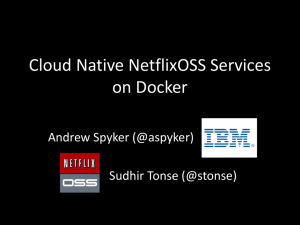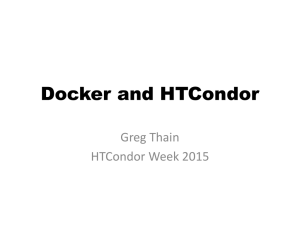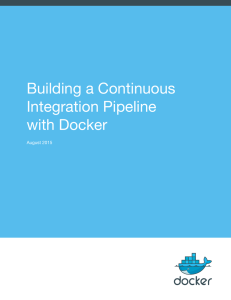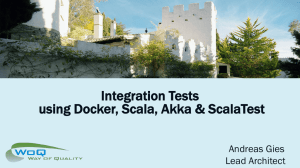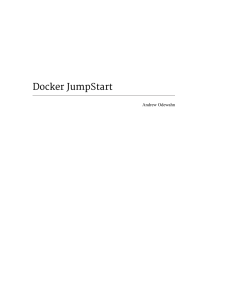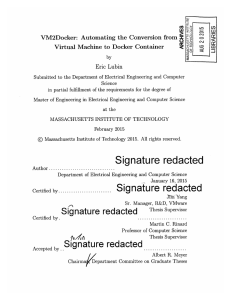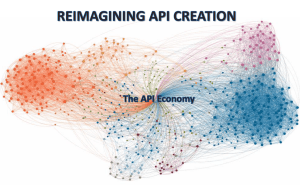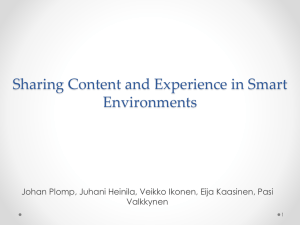docker images -tree - Blog
advertisement
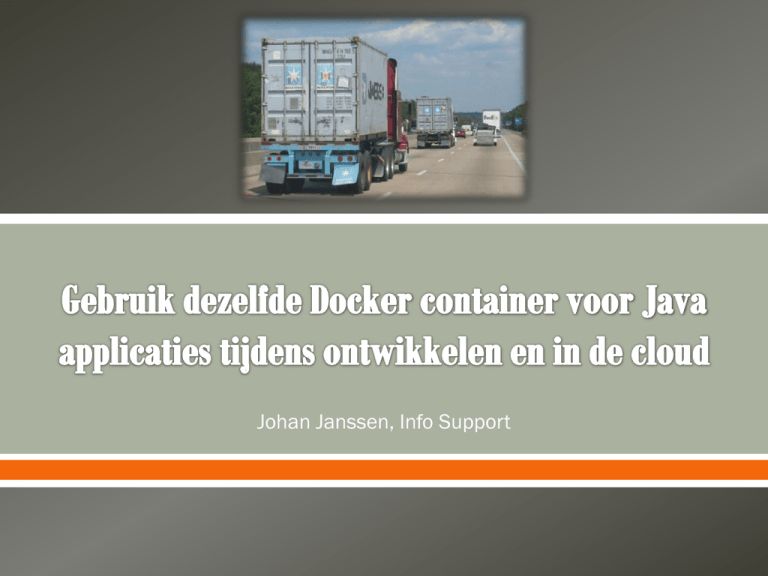
Johan Janssen, Info Support Continuous delivery Docker Jenkins Questions Automate everything Software quality Continuous improvement Regular deployments Anyone can deploy DevOps End users Automate environment provisioning Automate application deployment To enable continuous delivery Quickly provision environments Run the same software local and in the cloud Easy to move software Better performance Higher availability Cheaper Disk space efficiency Memory efficiency Speed Compatibility (run anywhere) Isolation Versioning Internet of Things (Raspberry Pi etc.) Simple general commands No Domain Specific Language (DSL) Configuration with operating system commands Since March 2013 8741 commits in 15 months More than 460 570 contributors Downloaded 2.75 13 million times More than 14000 30000 Dockerized apps >6500 Docker related projects on GitHub More than 90 user groups DockerCon (Europe) Support from Google, VMWare, RackSpace, Red Hat, IBM, Microsoft etcetera Docker on Ubuntu 14.04 apt-get install docker.io docker.io run -i -t ubuntu:saucy /bin/bash Main directory BuildAndRunScript.sh GeneralBase Dockerfile Sonar Dockerfile FROM ubuntu:saucy RUN apt-get -y install software-propertiescommon RUN add-apt-repository ppa:webupd8team/java RUN apt-get update && apt-get -y upgrade RUN echo "oracle-java7-installer shared/accepted-oracle-license-v1-1 boolean true" | debconf-set-selections RUN apt-get -y install oracle-java7-installer ENV JAVA_HOME /usr/lib/jvm/java-7-oracle FROM GeneralBase RUN apt-get install -y wget unzip RUN wget http://dist.sonar.codehaus.org/sonarqube4.2.zip RUN unzip sonarqube-4.2.zip -d /opt RUN rm sonarqube-4.2.zip EXPOSE 9000 EXPOSE 9092 CMD ["/opt/sonarqube-4.2/bin/linux-x86-64/sonar.sh", "console", "/bin/bash"] Create the Dockerfiles Build the containers: <optional>cd GeneralBase docker.io build -t GeneralBase . cd .. </optional> cd Sonar docker.io build -t Sonar . Start the container docker.io run -p 9000:9000 –p 9092:9092 -d Sonar # docker.io ps –a CONTAINER ID: ecbecf77461b CREATED: 32 minutes ago STATUS: Up 32 minutes PORTS: 0.0.0.0:9000->9000/tcp, 0.0.0.0:9092->9092/tcp Start / stop / restart docker [start/stop/restart] containerid Follow SystemOut and SystemErr docker logs -f containerid Show (running) containers docker ps –a Show processes running in container docker top containerid Show changes in the container docker diff containerid Stop all containers docker.io stop $(docker.io ps -a -q) Remove all containers docker.io rm $(docker.io ps -a -q) Remove all images docker.io rmi $(docker.io images -q) GeneralBase AppServerBase Environment D Environment T Environment A Environment P Jenkins Sonar JenkinsDataContainer Gitblit Nexus Dockerfile ENV JENKINS_HOME /var/JenkinsData Docker commands docker.io run -v /var/JenkinsData –name JenkinsDataContainer ubuntu:saucy true docker.io run -p 8080:8080 --volumes-from JenkinsDataContainer -d Jenkins # docker.io images --tree └─ 179.9 MB Tags: ubuntu:saucy └─253.6 MB └─741.8 MB Tags: GeneralBase:latest └─763.6 MB Tags: AppServerBase:latest … ├─763.6 MB Tags: EnvironmentP:latest └─865.6 MB Tags: Nexus:latest └─808.3 MB Tags: Gitblit:latest └─901.5 MB Tags: Sonar:latest └─805.4 MB Tags: Jenkins:latest real 4m11.729s user 0m3.329s sys 0m10.054s Creating the Docker registry docker run -p 5000:5000 registry Modify container Commit docker.io commit 064f 192.168.56.31:5000/test-version-0.2 New containerid -> ff7e Push docker.io push 192.168.56.31:5000/test-version-0.2 Pull docker.io pull 192.168.56.31:5000/ test-version-0.2 Run docker.io run -i -t ff7e /bin/bash View the changed container docker images -tree └─153b 194.2 MB test-version-0.1:latest docker pull 192.168.56.31:5000/testversion-0.2 ff7e: Download complete 153b: Download complete docker images -tree └─153b 194.2 MB test-version-0.1:latest └─ff7e 194.2 MB test-version-0.2:latest Simple to use Really popular Used in many organizations Regular updates Big community creating plugins etc. Most developers already use it 1 2 5 6 7 3 4 8 9 Continuous deployment Continuous delivery “Life is really simple, but we insist on making it complicated.” - Confucius Use a (private) Docker registry Use images from the registry instead of export Keep environmental settings separate Use Jenkins to manage everything Do not add extra functionality like OpenSSH Think about topics such as security, monitoring and logging Separate concerns in separate containers Inherit containers johan.janssen@infosupport.com http://blogs.infosupport.com/author/johanj/
